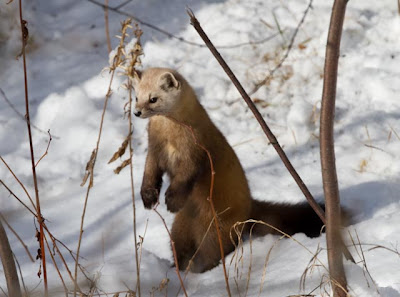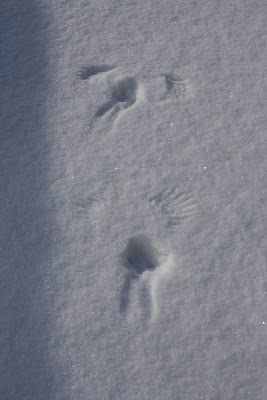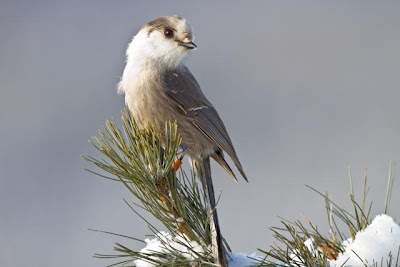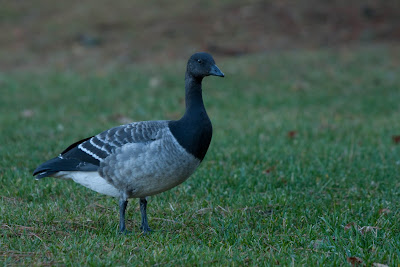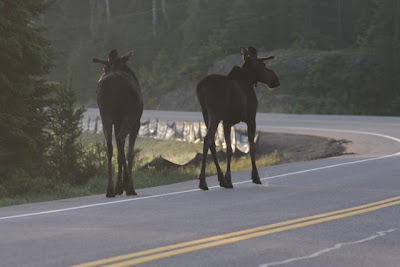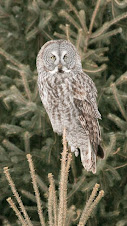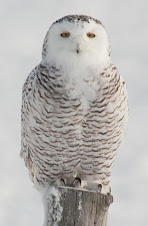WINTER FINCH FORECAST 2009-2010
General Forecast: The theme this winter is there will be no major finch irruptions outside their normal ranges. Finch numbers will be low and thinly distributed or absent in southern and northeastern Ontario and Quebec, where seed crops are poor. Higher numbers of finches should be attracted to much better cone crops in northwestern Ontario and west into northern Saskatchewan, the Maritime Provinces and Newfoundland, and northern New England States.
Key Finch Trees: The key tree species in Ontario's boreal forest triggering finch movements and distribution are white and black spruces, white birch,and mountain-ashes. South of the boreal forest in the mixed coniferous/deciduous forest region, white pine and hemlock are additional key finch trees. Other trees play a lesser role in finch movements, but often buffer main seed sources. These include tamarack, balsam fir, red pine, white cedar, alders, and yellow birch.
Tree Seed Crops: Spruce cone crops are poor in central Ontario such as
Algonquin Park and in northeastern Ontario and Quebec. However, spruce crops are good to excellent in the boreal forest north of Lake Superior and west into Saskatchewan. Spruce cone abundance is lower in Alberta and eastern Rocky Mountains, Yukon and Alaska, but is excellent in some high spruce zones of central British Columbia. East of Quebec, spruce crops are good to excellent in much of Eastern Canada including the island of Newfoundland. Heavy spruce crops are also reported in the northern New England States. The white pine cone crop is poor in central Ontario such as Algonquin Park and fair to good elsewhere in the province, but spotty. White pine crops are heavy in New Hampshire. The hemlock crop is almost zero in the province. The white birch crop is poor in central and northeastern Ontario and Quebec, but
improves westward in Ontario, becoming very good in Saskatchewan. Birch seed supplies are lower in Alberta and Alaska. The mountain-ash (rowan berry) crop is excellent across most of the boreal forest in Canada, including the island of Newfoundland where it is called dogberry.
INDIVIDUAL FINCH FORECASTS
Individual finch forecasts below apply mainly to Ontario, but neighboring provinces and states may find the forecast applies to them. An irruptive raptor and three irruptive passerines are also discussed.
Pine Grosbeak: Expect very little or no southward movement into southern Ontario because mountain-ash berry crops are excellent in most of the boreal forest. A few should get south to
Algonquin Park as in most winters.
Purple Finch: Most Purple Finches should migrate south out of the province this fall because many seed crops are poor in the north. This finch has declined significantly in recent decades.
Red Crossbill: This crossbill comprises at least 10 "call types" in North America. Each type has its cone preferences related to bill size and shape. The types are exceedingly difficult to identify in the field. Types 2 and 3 and probably 4 occur regularly in Ontario. Most Red Crossbills prefer pines, but the smallest-billed Hemlock Type 3 (= subspecies sitkensis of AOU Check-list 1957) prefers the small soft cones of hemlock and white spruce when bumper in Ontario. However, it should be absent from traditional areas such as
Algonquin Park where hemlock and white spruce occur together because these crops are poor there. White pine Type 2 is the most frequently encountered Red Crossbill in the province. Since white pine crops are low in most of the province, it should be rare to absent this winter. Other Red Crossbill types are possible in the province.
White-winged Crossbill: This crossbill has no subspecies or types in North America. In Ontario, it prefers the small soft cones of white, black and red spruces and hemlock. Many White-winged Crossbills left the province this past summer after last winter's irruption. Some went into northern Ontario attracted to the good spruce cone crops and were singing and presumably nested. These birds may remain in the north this winter and could breed again in mid winter if seed supplies last. White-winged Crossbills will be rare or absent this winter in traditional areas such as
Algonquin Park because spruce and hemlock cone crops are low. White-winged Crossbills
should appear this winter in Newfoundland and the Maritime Provinces and the
northern New England States, where spruce cone crops are good to heavy.
Common and Hoary Redpolls: Redpolls are a birch seed specialist in winter. Since the birch crop is poor in northeastern Ontario and Quebec, a few Common Redpolls should move south into southern Ontario and farther east and south. However, most redpolls may be drawn to good birch crops in northwestern Ontario and westward in the boreal forest into Saskatchewan.
Pine Siskin: Siskins are a conifer seed specialist when they winter in northern Ontario. Hemlock seed is another favorite in central Ontario. Most siskins departed the province early this past summer and appear to have gone mainly to western Canada. Banding recoveries show that siskins wander both ways between eastern and western North America. Siskins are currently very scarce in the Northeast. If siskins find good conifer crops in the Northwest, such as the interior of British Columbia, they will stay to winter and breed. It is uncertain whether many will return east this fall to winter in northwestern Ontario, the Maritime Provinces and northern New England States, where cone crops are good to excellent.
Evening Grosbeak: Breeding populations are much lower now than 35 years ago due mainly to a decrease of large outbreaks of spruce budworm beginning in the 1980s. A very few grosbeaks may move south from northeastern Ontario and Quebec where coniferous and deciduous seed supplies are generally poor. If any come, there are large crops of Manitoba maple seeds and plenty of sunflower seeds at feeders waiting for them.
FOUR MORE IRRUPTIVE SPECIES
Northern Goshawk: A good flight is very possible this fall or next. Goshawks in the boreal forest in winter prey on hares, grouse and red squirrels. Snowshoe Hares have been abundant in parts of northern Ontario the past few years and they should crash soon. Also, Ruffed Grouse likely had a poor breeding season due to a cool, wet spring and summer, which lowered chick survival.
Blue Jay: The flight began in the second week of September. This year's flight is much larger than in 2008 along the north shorelines of Lakes Ontario and Erie because most acorn, beechnut and hazelnut crops were poor this summer in Ontario with some local exceptions. Many fewer jays will winter in Ontario because most could not find enough food to store.
Red-breasted Nuthatch: Movements of this nuthatch in Ontario are linked to cone crop abundance, particularly white spruce, white pine and balsam fir when bumper. There has not been a noticeable southward movement along Lakes Ontario and Erie, indicating this is not an irruption year for it and associated winter finches such as White-winged Crossbills and Pine Siskins. However, Red-breasted Nuthatches will be scarce this winter in central Ontario such as
Algonquin Park and in northeastern Ontario and Quebec because cone crops there are generally poor in these areas. Many nuthatches likely dispersed to better cone crops north and west of Lake Superior and
east to the Maritime Provinces.
Bohemian Waxwing: Like the Pine Grosbeak, this waxwing is a mountain-ash berry specialist in winter. Mountain-ash crops are high around Lake Superior and in many areas of northern Ontario. Crops are also good in Quebec, Newfoundland and northern New England States so this nomad may show up in these areas this winter. Its breeding and winter ranges in eastern North America have expanded in recent times. Range maps in field guides show Bohemians breeding east to James Bay, but recently they have been found in summer scattered across northern Quebec and Labrador. Historically they were very rare in winter on the island of Newfoundland, but are now abundant there some winters. Their winter range movements have also expanded to other eastern areas because of planted European mountain-ashes and ornamental
crabapples.
WHERE TO SEE FINCHES:
A winter trip to Algonquin Park is always a birding adventure. The park is a three hour drive north of Toronto. Finch numbers will be low in Algonquin this winter, but the feeders at the Visitor Centre should attract a few Evening Grosbeaks, Pine Grosbeaks and redpolls. Gray Jays frequent the suet feeder and sometimes a Pine Marten or Fisher feeds on the suet. An observation deck overlooks a spectacular boreal wetland and black spruce/tamarack forest. Eastern Canadian Wolves (Canis lycaon), which until recently was a subspecies of the Gray Wolf, are seen occasionally from the observation deck feeding on road-killed Moose put out by park staff. The Visitor Centre and restaurant at km 43 are open on weekends in winter. Arrangements can be made to view feeders on weekdays. For information, call the Visitor Centre at 613-637-2828. The Spruce Bog Trail at km 42.5 near the Visitor Centre and the gated area north on the Opeongo Road are the best
spots for finches, Gray Jay, Boreal Chickadee, Spruce Grouse and Black-backed Woodpecker.
FINCHES AND TREES: A good knowledge of trees is essential to understanding winter finch habitats, food preferences and distributions. By coincidence, the finch forecast comes out the same week as the new "The Sibley Guide to Trees". In a recent interview with Birder's World, David Sibley said "I wanted it to be a tree guide for birdwatchers".
Previous finch forecasts archived at OFO website.
http://www.ofo.ca/reportsandarticles/pastwinterfinches.php
Previous finch forecasts archived at Larry Neily's website.
http://ca.geocities.com/larry.neily@rogers.com/pittaway-old.htm
ACKNOWLEDGEMENTS: I thank staff of the Ontario Ministry of Natural Resources from across the province designated by an asterisk* and many others whose reports allow me to make annual forecasts: Ken Abraham* (Hudson Bay Lowlands), Dennis Barry (Durham Region), Eleanor Beagan (Prince Edward Island), Syd Cannings (Yukon), Ken Corston* (Moosonee), Pascal Cote (Tadoussac, Quebec), Shirley Davidson (Minden/Dorset), Bruce Di Labio (Ottawa), Carrolle Eady (Dryden), Cameron Eckert (Yukon), Nick Escott (Thunder Bay), Brian Fox* (Timmins), Marcel Gahbauer (Alberta), Stacy Gan* (James Bay), David Govatski (New Hampshire), Skye Haas (Michigan), Charity
Hendry* (Ontario Tree Seed Plant), Leo Heyens* (Kenora), Tyler Hoar, George Holborn* (Thunder Bay), David Hussell*, Peter Hynard (Haliburton and Maine), Jean Iron (Northeastern Ontario/James Bay), Bruce Mactavish (Newfoundland), Erwin Meissner (Massey), Brian Naylor* (North Bay), Stephen O'Donnell (Parry Sound District), Mark O'Donoghue (Yukon), Fred Pinto* (North Bay), Rick Salmon* (Lake Nipigon), Harvey and Brenda Schmidt (Creighton, Saskatchewan), Chris Sharp (Trent University), Don Sutherland* (Northern Ontario), Eve Ticknor (Ottawa), Ron Tozer (Algonquin Park), Declan Troy (Alaska), Mike Turner* (Minden), Mike Walsh* (Muskoka), John Woodcock (Thunder Cape Bird Observatory), Matt Young has been very helpful with seed crop information from New York State, and Kirk Zufelt (Sault Ste Marie ON). Jean Iron
provided many helpful suggestions and proofed the forecast.
Ron Pittaway
Ontario Field Ornithologists
Minden ON
19 September 2009
E-MAIL STAY@ALGONQUININN.COM




